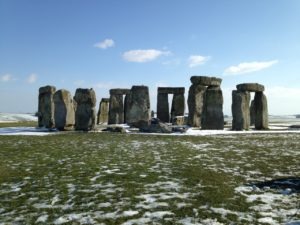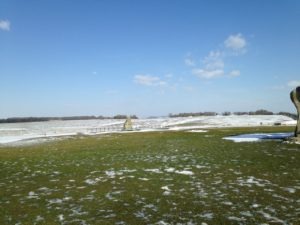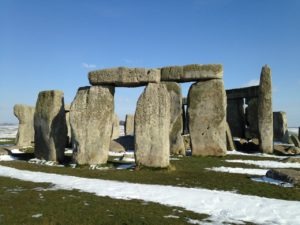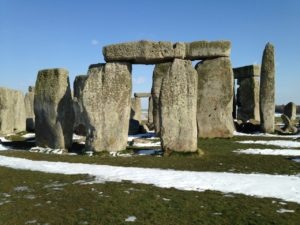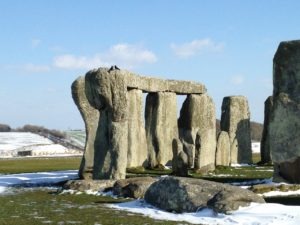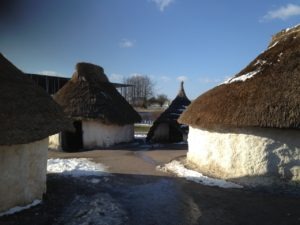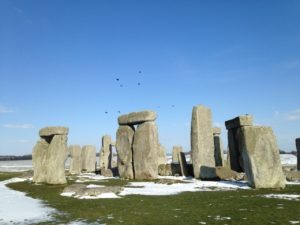During the recent winter solstice, people gathered at Salisbury Plain in England to watch the sunrise over one of the most ancient and mysterious sites in the world – Stonehenge. It was a some years ago that I, myself, gazed upon this megalithic structure. Although much has been learned about Stonehenge thanks to archeological research, it still remains quite enigmatic and there are many questions yet to be answered.
It’s been determined that the Stonehenge we see today is the result of multiple phases of construction that roughly spanned from 3000 BC to 1600 BC. It consists of a round earthwork enclosure with circular arrangements of standing stones, consisting of smaller bluestones and larger sarsens (sandstones). Evidence suggests the bluestones were quarried 100-150 miles away while the sarsens came from about 20 miles way. There are also stones in various positions independent of the circular patterns. 56 holes (known as “Aubrey Holes”) were discovered at the site, many of which contained or were near the burials of cremated remains. Naturally, over the course of time, some stones have fallen, been damaged, or are no longer there. As such, the site today doesn’t exactly look as it did at its height. Around Stonehenge are various barrows (burial mounds) that are visible as you look over the plain.
Stonehenge is also famously known for its astronomical alignments. Sunrise on the summer solstice aligns with the main corridor of the structure and an outlying stone known as the Heel Stone. Sunset on the winter solstice aligns with that same corridor and the space between two upright sandstones (one of which is now gone). The sun would then disappear behind the Altar Stone. It is also surmised that there are alignments with the lunar cycle.
Of course, many people have wondered about the builders of Stonehenge. In the 16th century, it was theorized that high-ranking Celtic religious leaders, known as Druids, had constructed it. However, radiocarbon dating has shown that Stonehenge predates the presence of Celts in that area. Still, modern-day Druids gather at Stonehenge to celebrate.
Another far older belief relates to giants and the legendary wizard Merlin. Around the year 1136, Geoffrey of Monmouth states in his Historia Regum Britanniae that Stonehenge was erected by the decree of King Aurelius Ambrosius (uncle of the future King Arthur). Its purpose was to commemorate a number of the king’s followers who had been killed at the hands of his enemy, Vortigern. In order to decide what kind of monument would be suitable, the king turned to Merlin. The wizard’s advice was to retrieve the stones of a structure known as the Giant’s Dance, which was located on Killaraus Mountain in Ireland. An 1801 excerpt and translation of Monmouth’s work (from a book titled A Description of Stonehenge, on Salisbury Plain) states the following:
These stones, continues Merlin, are mystical, and of medicinal virtue. The giants of old brought them from the farthest coasts of Africa, and placed them in Ireland, while they inhabited that country. Their design in this was to make baths in them, when they should be taken with any illness; for their method was to wash the stones, and put their sick into the water, which infallibly cured them. With the like success they cured wounds also, adding only the application of some herbs; and there is not a stone there, concluded Merlin, which has not some healing virtues.
The king’s brother, Uther (father to the future King Arthur), goes to retrieve the stones with Merlin and 15,000 men. Merlin first lets the army attempt to move the stones, using cables, ropes, etc. as they saw fit. Their attempt failed and the stones didn’t budge. As the story then goes:
Merlin, laughing at their vain efforts, then began his own contrivances; and when he had placed the engines in their proper order, which he thought necessary for the work, he took down the stones with incredible facility, and withal gave directions for carrying them to Mount-Ambre.
Once the stones are in Briton, Merlin reassembles them exactly as they were in Ireland. I find it interesting that the account doesn’t actually state that Merlin used magic. Rather, he seemed to know the proper engineering techniques needed to extract and transport the stones.
In 1155, a poet known as Wace composed a French translation and adaptation of Monmouth’s work, known as Roman de Brut. The Stonehenge account appears in it and the overall story is roughly the same. Between 1338 and 1340, an abridged version of Wace’s work was produced in Britain. The manuscript contains numerous illustrations, one of which is the oldest known image of Stonehenge. It depicts three men standing by some of the upright stones. Two of them are average-sized while the third figure is much larger and is grasping a top stone. The interpretation is that one of the smaller figures is Merlin and he is directing a giant. They are either disassembling the circle in Ireland or rebuilding it in England. Thus, the notion of giants is further linked to Stonehenge.
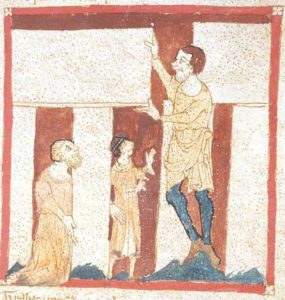
Source: British Library via Wikimedia Commons
There may actually be a small grain of truth in Monmouth’s tale. Recent research has shown that the bluestones present at Stonehenge may have originally been part of a stone circle in Wales known as Waun Mawn. Ancient stone holes were discovered at Waun Mawn and the sediment was dated to shortly before the construction of Stonehenge. In one of the holes was a small fragment of stone, its rock type matching three of the bluestones. Perhaps most striking is that the shape of one of the holes perfectly matches up to the shape of one of the bluestones. Could Merlin’s expedition to retrieve Stonehenge from Ireland be a distant echo of the bluestones being moved from Wales?
The exact purpose of Stonehenge is still subject to speculation. It certainly seems to have been a burial site and it may have had ceremonial or spiritual purposes beyond that. The structure was built and changed during a number of phases, likely by different groups. It would also now appear that Neolithic people moved to the area in 3000 BC, bringing with them their sacred stones from Wales.
Today, Stonehenge is a UNESCO World Heritage site and is managed by English Heritage. The parking lot and visitor center are located about a mile from the stones. You’ll go there first for tickets. You’ll then be able to board a shuttle bus that will take you to Stonehenge itself. The visitor center also has excellent exhibits about the site, along with a gift shop, café, and bathrooms. Outside the visitor center is an area with recreations of Neolithic houses.
Ultimately, Stonehenge remains a mysterious and mystical place. By visiting, we get a view into the prehistoric past. We are left to wonder the true purposes of this place and the intentions of the people who built it thousands of years ago.
Location
Salisbury SP4 7DE
UK
Official site: english-heritage.org.uk/visit/places/stonehenge/
Sources
Carylsue. “Parts of Stonehenge May Have Been In Place Long Before Humans.” National Geographic Education Blog. April 12, 2018. https://blog.education.nationalgeographic.org/2018/04/12/parts-of-stonehenge-may-have-been-in-place-long-before-humans/.
“Celestial Stonehenge.” English Heritage. https://www.english-heritage.org.uk/visit/places/stonehenge/things-to-do/stone-circle/celestial-stonehenge/.
“Description of Stonehenge.” English Heritage. https://www.english-heritage.org.uk/visit/places/stonehenge/history-and-stories/history/description/.
A Description of Stonehenge, on Salisbury Plain; Extracted from the Works of the Most Eminent Authors: with Some Modern Observations on that Stupendous Structure: To which is Added, an Account of the Fall of Three Stones, Jan. 3, 1797. United Kingdom: J. Easton … Sold also by Messrs. Crosby and Letterman … London, 1801. https://www.google.com/books/edition/A_Description_of_Stonehenge_on_Salisbury/16OS9Ef9STEC.
Harrison, George. “What are Druids and what do they do at Stonehenge on the summer solstice?” The US Sun. June 20, 2020. https://www.the-sun.com/lifestyle/1013431/druids-stonehenge-summer-solstice/.
History.com Editors. “Stonehenge.” HISTORY. A&E Television Networks. January 1, 2010. https://www.history.com/topics/british-history/stonehenge.
Pearson, M. Parker. “Stonehenge.” Encyclopedia Britannica, March 2, 2021. https://www.britannica.com/topic/Stonehenge.
Pearson, Mike Parker. “Stonehenge first stood in Wales: how archaeologists proved parts of the 5,000 year-old stone circle were imported.” The Conversation. February, 15, 2021. https://theconversation.com/stonehenge-first-stood-in-wales-how-archaeologists-proved-parts-of-the-5-000-year-old-stone-circle-were-imported-155315.
“Set in Stone.” Medieval Manuscripts Blog. British Library. July 15, 2014. https://blogs.bl.uk/digitisedmanuscripts/2014/07/set-in-stone.html.
“Questions and Answers.” English Heritage. https://www.english-heritage.org.uk/visit/places/stonehenge/plan-your-visit/questions-and-answers/.
Wace. Arthurian Chronicles: Roman de Brut. Translated by Eugene Mason. December 1, 2003. https://www.gutenberg.org/ebooks/10472.
Written by A. P. Sylvia

